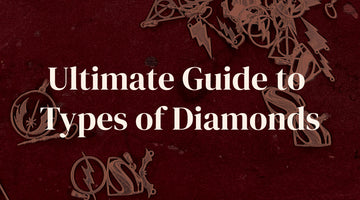When you think of diamonds, the first image that pops into your mind might be a glittering engagement ring, with someone down on one knee, and a teary-eyed "Yes!"—all thanks to every rom-com ever. But, let's be honest, there's way more to diamonds than just popping the question. Diamonds are like the superheroes of the gem world, each with its own unique powers (or in this case, characteristics). Today, we're diving into the fascinating world of diamonds, exploring their variety, clarity, color, cut, and those all-important types. Whether you’re planning to add some sparkle to your life or just want to impress your friends with some gem knowledge, you’ve come to the right place.
Also Read: What is Sterling Silver? A Guide for the Curious & Stylish Wall-E’s
Diamond Variety: The Avengers of the Gem World
Diamonds, like your favorite superheroes, come in different varieties, each with its own special powers—or, more accurately, properties. When we talk about diamond variety, we're diving into the types of diamonds based on how they're created. Think of it like this: You've got your classic comic book superheroes (natural diamonds) and your modern-day movie adaptations (lab-grown diamonds).
- Natural Diamonds: These are the OGs of the diamond world. Formed over billions of years deep within the Earth's mantle, they’re the epitome of "timeless." Natural diamonds are for those who want a piece of Earth's history in their jewelry box.
- Lab-Grown Diamonds: Just like how CGI brings superheroes to life, technology gives us lab-grown diamonds. They have the same physical, chemical, and optical properties as natural diamonds, but without the billion-year wait. Plus, they’re often more affordable, making them a hit with the environmentally conscious and budget-savvy crowd.
- Fancy Color Diamonds: If natural and lab-grown diamonds are the Avengers, fancy color diamonds are the Guardians of the Galaxy—quirky, colorful, and definitely not your average gem. These diamonds get their hues from trace elements and structural anomalies, resulting in vibrant shades like pink, blue, green, and yellow.
Types of Diamond Names: Decoding the Diamond Lingo
In the diamond world, names are everything. The types of diamond names are like the alter-egos of your favorite superheroes—important to know if you want to fully appreciate their superpowers.
- Brilliant Cut: The most famous name in the diamond game, the Brilliant Cut is like the Captain America of diamonds—classic, timeless, and universally loved. Its 58 facets are designed to maximize light reflection, giving it that signature sparkle.
- Princess Cut: The Princess Cut is the Wonder Woman of diamonds—bold, striking, and with a square or rectangular shape that stands out in any crowd. It's the go-to choice for those who want a blend of modern style and classic brilliance.
- Cushion Cut: Think of the Cushion Cut as the Black Widow—vintage and sophisticated with a slightly rounded square shape that’s soft yet striking. This cut has been around for over 200 years and is perfect for those who appreciate a touch of old-world charm.
- Emerald Cut: The Emerald Cut is the Tony Stark—sleek, sophisticated, and with a long, rectangular shape that demands attention. Its step cuts are perfect for showcasing the diamond’s clarity, making it a favorite among the elite.
- Marquise Cut: The Marquise Cut is the Loki of the diamond world—elegant, with a unique elongated shape that’s both mischievous and eye-catching. Its distinctive outline maximizes carat weight, making the diamond appear larger than it actually is.
Also Read: Shining a Light on Lab-Grown Diamonds: What, How, and Are They Real?
Diamond Category: The Justice League of Quality
Just as superheroes belong to different teams or leagues, diamonds are categorized based on their quality, specifically their clarity, color, and cut. These categories determine a diamond’s overall appeal and, of course, its price tag.
Clarity: The Diamond’s Origin Story
In the world of diamonds, clarity is like the backstory of a superhero—it's all about how much drama your diamond has faced on its journey to becoming the sparkly gem it is today. Clarity refers to the presence of internal flaws (inclusions) and external flaws (blemishes) in a diamond. The fewer of these imperfections, the higher the diamond's clarity, and the more it resembles an untarnished hero straight out of a Marvel movie.
- Flawless (FL): A diamond with no inclusions or blemishes visible under 10x magnification is the Superman of diamonds—perfect in every way. It's as rare as a blockbuster without a sequel.
- Internally Flawless (IF): These diamonds have no internal flaws but might have some surface blemishes. Think of them as Bruce Wayne—rich and almost flawless, with a few surface scars.
- Very, Very Slightly Included (VVS1 and VVS2): These diamonds have tiny inclusions that are difficult to see even under 10x magnification. They're like Tony Stark—brilliant with a few quirks, but nothing that diminishes their value.
- Very Slightly Included (VS1 and VS2): With small inclusions that are visible under magnification but not to the naked eye, these diamonds are like Spider-Man—charming and high-performing, with just a touch of humanity.
- Slightly Included (SI1 and SI2): Inclusions are more easily visible under magnification, and might even be noticeable to the naked eye in SI2 diamonds. Think of them as the X-Men—remarkable but with obvious flaws that give them character.
- Included (I1, I2, I3): These diamonds have obvious inclusions that may affect their transparency and brilliance. They’re like Deadpool—flawed, but still lovable if you appreciate their unique character.
Also Read: Shine Bright Like a Silver: The Ultimate Guide to Silver Jewelry
Color: The Costume of Your Superhero Diamond
When it comes to diamonds, color isn’t about vibrant hues (unless we're talking about fancy color diamonds, but that’s a different story). Instead, it's about how little color a diamond has. The closer a diamond is to being colorless, the higher its value. It’s like picking the perfect costume—do you go for the classic, clean look, or something with a bit of an edge?
- D to F (Colorless): These diamonds are the Batman of the gem world—dark, mysterious, and always on point. They have virtually no color, making them the most sought-after.
- G to J (Near Colorless): Slight traces of color are present, but it’s hard to notice unless you’re really looking. They’re like Iron Man—still top-tier, with just a hint of flair.
- K to M (Faint Color): These diamonds have a faint yellow or brown tint that gives them a warm, vintage vibe. Think of them as Wonder Woman—classic with a bit of an old-world touch.
- N to R (Very Light Color): The tint becomes more noticeable, giving these diamonds a distinct look. They’re like Doctor Strange—unconventional, with an otherworldly appeal.
- S to Z (Light Color): These diamonds have a noticeable color, often a light yellow or brown. They’re the Harley Quinn of diamonds—bold, quirky, and not for everyone, but definitely unique.
Cut: The Training Regimen of a Superhero
The cut of a diamond is like the training regimen of a superhero—it's what turns potential into pure power. A diamond’s cut isn’t just about its shape; it’s about how well the diamond has been crafted to interact with light. A well-cut diamond can make even a lower color or clarity diamond look dazzling, just like a well-trained hero can outshine even the mightiest villain.
- Excellent: This is the top of the line, where every facet is perfectly proportioned to reflect the maximum amount of light. It’s the equivalent of Captain America’s shield—impeccably crafted and utterly reliable.
- Very Good: A diamond with a very good cut reflects most of the light that enters it. It’s like Thor’s hammer—powerful and striking, though not quite on the level of perfection.
- Good: These diamonds are well-cut, but not perfectly. They still reflect a good amount of light but may not have the same brilliance as higher-grade cuts. They’re like Black Widow—effective and reliable, with just a touch of human imperfection.
- Fair: A fair-cut diamond reflects less light, making it less brilliant. It’s like Hawkeye—skilled and capable, but not the brightest star in the lineup.
- Poor: A poor-cut diamond doesn’t reflect much light, making it less radiant. It’s like the Hulk—there’s potential, but it’s not being fully realized.
Technical Details of Types of Diamonds: The Science Behind the Sparkle
Now, let's get into the nitty-gritty—because every superhero has their origin story, and every diamond has its technical details. When we talk about the "type" of diamond in a technical sense, we're referring to its atomic structure and nitrogen content. Yep, we're going full-on science mode here.
- Type Ia Diamonds: These are the most common diamonds, making up about 95% of natural diamonds. They contain clusters of nitrogen atoms that absorb blue light, often giving these diamonds a slight yellow tint. They're like the Batman of diamonds—popular, with just a hint of darkness.
- Type Ib Diamonds: Much rarer, these diamonds contain isolated nitrogen atoms, giving them a strong yellow or brown color. They’re the Daredevils of the diamond world—rare and with a strong, distinct character.
- Type IIa Diamonds: These are the purest diamonds, with no measurable nitrogen or boron impurities. They're incredibly rare, making them the Superman of diamonds—pure, powerful, and almost mythical. Many famous diamonds, like the Koh-i-Noor, are Type IIa.
- Type IIb Diamonds: These diamonds are super rare and contain boron, which gives them a blue or gray hue and makes them semiconductors. They’re the Tony Stark of diamonds—rare, high-tech, and always cool under pressure.
Business Promotion: Bling Like a Superhero
At The Blinwiz, we believe that everyone deserves to feel like a superhero, and what better way to do that than with a diamond that reflects your unique style and story? Whether you're drawn to the classic elegance of a Brilliant Cut, the bold statement of a Princess Cut, or the rare beauty of a Type IIa diamond, we've got the perfect piece waiting for you. Although we might not have the pieces of your wish kept in inventory, we're here! We will customize and bring it to life.
Diamonds are more than just pretty rocks—they're the ultimate blend of nature, science, and artistry. Whether you're shopping for an engagement ring, a special gift, or just treating yourself, understanding the types of diamonds and what makes each one unique can help you find the perfect gem. And who knows? With the right diamond, you might just feel like you have superpowers, too.

